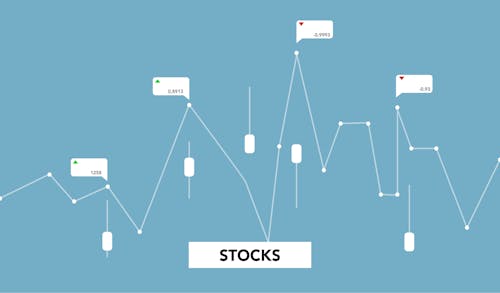Jitters On Wall Street: Yet Another Tech Shakeout

Image Source: Pexels
MARKETS
Another pre-earnings shake-out gave Wall Street yet another case of the jitters on Thursday. It seems that investors are starting to wonder if the AI-fueled joyride might hit a few potholes. The big question: Can these tech titans turn their grand plans into actual profits? As the week rolls on, wary investors are slowly stepping away from the "Magnificent Seven" tech stocks that have driven the market to new heights all year.
The S&P 500 took a 0.8% nosedive, slipping further from its peak. The Dow Jones Industrial Average wasn't any luckier, plummeting 533 points, or 1.3%, from its record high set just the day before. Meanwhile, the Nasdaq composite fell 0.7%, clearly in no mood to be left out.
Following the trend from the previous day, when the Nasdaq experienced its worst drop since 2022, several Big Tech heavyweights led the market's descent. Apple (AAPL) lost 2%, Amazon (AMZN) dropped 2.2%, and Microsoft (MSFT) dipped 0.7%, putting quite a dent in sentiment. It's almost as if these tech giants decided to go on a synchronized dive—unfortunately, without the grace of Olympic divers.
Shares of smaller companies, which usually thrive in a lower-rate environment, started a rally last week, giving the Dow a boost to new highs. However, the small-cap stocks have recently hit the brakes: the Russell 2000, which tracks U.S. small caps, dropped 1.8% on Thursday. Concerns about the broader U.S. economy, highlighted by higher-than-expected weekly jobless claims, seem to be waving a red flag.
With the US economy on the cusp of a not-so-leisurely nap, companies might find it tricky to hike prices when everyone's suddenly tightening their purse strings. And that's certainly no jackpot for lower-quality companies trying to flex their pricing muscles. It's like trying to sell ice to Eskimos—challenging and not particularly profitable!
Tech shares might correct further, or they might not. I'm not Oracle (though I still own their stock despite Ellison selling), but we know that big-cap U.S. tech was down about 4% over two sessions. This drop came as geopolitical tech jitters collided headfirst with pre-earnings season profit-taking, dragging down the consensus favourites.
Should we be worried about the geopolitical landscape? Absolutely. A “Trumponian” tech war with China, aiming to curb the development of China’s technological capabilities, could make the current trade war over EV cars look like a simple board game of Monopoly. It's like comparing a high-stakes chess match to a leisurely round of tic-tac-toe!
Still, the end game remains consistent each quarter, especially for the mega-cap companies that drive the index. Generally, these corporate giants reliably meet or exceed expectations with their financial results. They've become integral to regular and business folks worldwide. While performance may occasionally dip, few quarters can be objectively labelled as poor. The notion of a "bad" quarter often hinges on a Wall Street analyst’s subjective measures rather than on actual balance sheet flaws. It's like calling a gourmet meal "bad" because the dessert wasn't to your taste—hardly a disaster in the grand scheme!
FOREX MARKETS
As every trader on the street predicted, Christine Lagarde and her team could not make a July move after venturing into the cautious territory of a first-rate cut a few weeks ago at the June policy meeting. The bank is widely expected to cut again in September, assuming inflation decides to play nice.
The latest statement kept a wary eye on inflation. Officials noted that the current policy settings are "keeping financing conditions restrictive". However, they acknowledged that "domestic price pressures are still high, services inflation is elevated, and headline inflation is likely to remain above the target well into next year." It's as if inflation is that stubborn houseguest who won't leave no matter how long you keep rates restrictive.
Counterintuitively, the Euro fell despite the ECB holding rates steady. Even with traders anticipating the Fed will cut rates more quickly and aggressively than the ECB, the Euro slipped. This suggests France’s policy turmoil looms like a dark cloud over the Euro. It’s as if the Euro decided to play limbo with its value—how low can you go?
As for the BoJ's next step toward policy normality and its impact on the Yen, FX traders shouldn't start measuring for new drapes just yet. Today's Japan CPI print might change the tone. Still, it's a familiar story: after the supposed intervention scare runs its course, a USDJPY bid kicks in, driven by yawning interest rate differentials. Investors of all kinds, including the famous Mrs. Watanabe and the Japanese retail crowd with their insatiable appetite for all things carry trade, push USDJPY back near intervention levels. It will take a tectonic shift in domestic policy and three Fed cuts for the USDJPY to have any hope of returning to sub-150 levels. Indeed, it's a simple case of harvesting the carry while the going is good.
The big lesson for retail FX traders: if you look hard enough, you can always find a technical level to justify a bad trade, as evidenced by my attempt to frame a bullish yen narrative around technical levels yesterday. It's like trying to find a silver lining in a storm cloud—sometimes, it's just a storm cloud and not a bullish Ichimoku crossover cloud!
But let me be clear: outside of the USDJPY intervention and the occasional random walk, FX land is as dull as watching paint dry on a ship's hull.
More By This Author:
Forex: A Yearning For The Yen
The Start Of A "Teutonic Tech Trashing" ?
Forex: Federal Reserve Easing Vs. The Impact Of The Trump Trade



